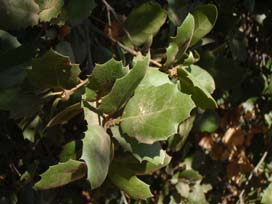
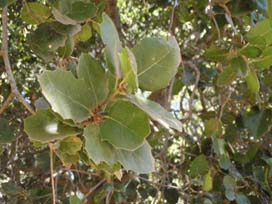
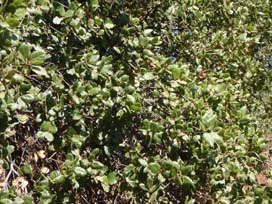
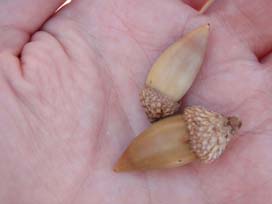
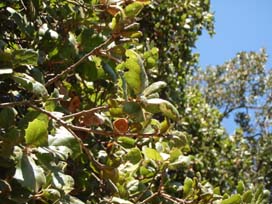
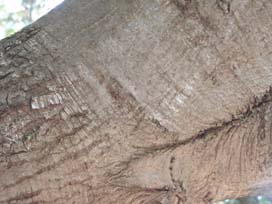
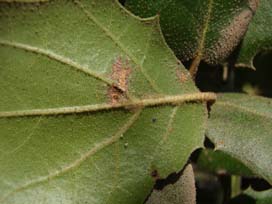
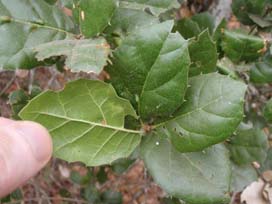
coast live oak
Quercus agrifolia
Family: Fagaceae.
Type: Evergreen tree.
Branching: Alternate.
Oak Group: Black.
Leaves: As a black oak, its leaves are green on both sides. Leaf margins are consistently toothed, with bristles on the teeth; this is not variable as it is in the shreve oak. The leaves have a somewhat pillowed, cupped shape (in contrast to the shreve oak's flat leaves). A distinctive characteristic is fuzz between the veins on the underside of the leaf near the petiole (close-up below). This fuzz, called "hairy armpits", is indicative of coast live oak, but it rubs off, so the absence of hairy armpits does not mean the tree is not a coast live oak.
Twig: The bark of the mature tree is smooth, wrinkly, and medium to dark gray, like the leg of an elephant. The oldest parts of the trunk may break into furrows.
Fruit & Flower: The acorn is very similar to that of the shreve oak. As a black oak, its cap scales are smooth and pressed together. Acorns take only a single year to develop in the coast live oak, unlike the shreve oak. Hybrids between the coast live and the shreve, which are common, will have toothed margins, hairy armpits, but two-year acorns.
Miscellaneous: The coast live oak is more shade-tolerant than the blue or valley oaks, probably about the same as the shreve oak and canyon live oak. It is more fire-resistant (due to its thick bark) than other oaks. It tends to be found in mesic (moist) areas, but it is quite widespread and is actually the most drought-tolerant of the oaks we will cover (as can be observed from the fact that we are near the northern end of its range here). Due to its shade-tolerance, it commonly comes in under and around other trees. The Bay Area is near the northern end of the range of the coast live oak; it is found across southern California.
The coast live oak is one of the oaks most susceptible to sudden oak death, caused by fungal infections of Phytophthera ramorum. This fungus invades the wood tissue of tanoak and the black oaks, blocking the flow of phloem and sometimes xylem, which can kill these trees rapidly or can erode their ability to resist beetles or other infections. Sudden oak death was probably introduced horticulturally in both the U.S. and Europe. It appeared in California in 1994 or 1995. Other trees, such as madrone, manzanita, coffeeberry, and oceanspray, can become wood-infected as well, but not as strongly as the oaks. Some other trees, such as Douglas-fir, coast redwood, bigleaf maple and California bay can be infected in their leaves; the infected leaves are typically dropped, so the infected tree is not killed, but the dropped leaves spread the infection. Diverse forests are therefore typically harder hit than pure oak woodlands. Fire may kill the spores and acidify the soil in such a way as to exclude sudden oak death, but this is not entirely clear. Excluding bays in some areas has been proposed to stop the spread of the disease.
 |
 |
 |
 |
 |
 |
 |
 |